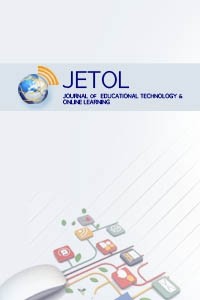Psycho-social and Educational Dimension of the COVID-19 Lockdown for Elementary School Students
Psycho-social and Educational Dimension of the COVID-19 Lockdown for Elementary School Students
___
- Abdulamir, A. S., & Hafidh, R. R. (2020). ‘Abdulamir, A. S., & Hafidh, R. R. (2020). The Possible Immunological Pathways for the Variable Immunopathogenesis of COVID--19 Infections among Healthy Adults, Elderly and Children. Electronic Journal of General Medicine, 17(4).
- Baltar, F., & Brunet, I. (2012). Social Research 2.0: Virtual Snowball Sampling Method Using Facebook. Internet Research 22 (1), 57-74.
- Basilaia, G., & Kvavadze, D. (2020). Transition to online education in schools during a SARS-CoV-2 coronavirus (COVID-19) pandemic in Georgia. Pedagogical Research, 5(4), 1-9.
- Birmaher, B., Brent, D. A., Chiappetta, L., Bridge, J., Monga, S., & Baugher, M. (1999). Psychometric properties of the Screen for Child Anxiety Related Emotional Disorders (SCARED): A replication study. Journal of the American Academy of Child and Adolescent Psychiatry, 38(10), 1230-1236.
- Brazendale, K., Beets, M. W., Weaver, R. G., Pate, R. R., Turner-McGrievy, G. M., Kaczynski, A. T., ... & von Hippel, P. T. (2017). Understanding differences between summer vs. school obesogenic behaviors of children: the structured days hypothesis. International Journal of Behavioral Nutrition and Physical Activity, 14(1), 100.
- Brooks S.K., Webster R.K., Smith L.E., Woodland L., Wessel S., Greenberg N., Rubin, G. J. (2020). The psychological impact of quarantine and how to reduce it: rapid review of the evidence. The Lancet. 395, (10227), 912-920.
- CCTV News. (2020, Feb 17). Ministry of Education: national elementary and middle school network cloud platform opens for free use today. CCTV News. Accessed July 2 2020. http://www.chinanews.com/sh/2020/02-17/9094648.shtml
- Chew, Q.H., Wei, K.C., Vasoo, S., Chua, H.C., & Sim, K. (2020). Narrative synthesis of psychological and coping responses towards emerging infectious disease outbreaks in the general population: practical considerations for the COVID-19 pandemic. Singapore Medical Journal. 2020, 1-31. doi:10.11622/smedj.2020046
- Creswell, J. W. (2003). Research design: qualitative, quantitative and mixed methods approaches. California: Sage Publications.
- Çakmakçı F.K. (2004): Çocuklarda Anksiyete Bozukluklarını Tarama Ölçeği Geçerlik ve Güvenirlik Çalışması [Validity and Reliability Study of SCARED], Çocuk ve Gençlik Ruh Sağlığı Dergisi, 11(2).
- Danese, A., Smith, P., Chitsabesan, P., & Dubicka, B. (2020). Child and adolescent mental health amidst emergencies and disasters. The British Journal of Psychiatry, 216(3), 159-162.
- Erikson, E.H. (1963). Childhood and society. New York: W.W. Norton and Company.
- Glaser, B. G. & Strauss, A. (1967). The Discovery of grounded theory: Strategies for qualitative research. New York: Aldine.
- Kondracki, N. L., Wellman, N. S., & Amundson, D. R. (2002). Content analysis: Review of methods and their applications in nutrition education. Journal of Nutrition Education and Behavior, 34 (4), 224-230.
- McCloskey, B., Zumla, A., Ippolito, G., Blumberg, L., Arbon, P., Cicero, A., ... & Borodina, M. (2020). Mass gathering events and reducing further global spread of COVID-19: a political and public health dilemma. The Lancet, 395 (10230), 1096-1099.
- Mayring, P. (2004). Qualitative content analysis. A companion to qualitative research, 1, 159-176.
- Redmond, T. (2010). The Teacher’s Role in Enforcing Hand Washing Techniques Among School-Aged Children in the Midst of the H1N1 Pandemic. Perspectives in Learning, 11(1), 33-38.
- Rich, L. L., Cowan, W., Herring, S.D., & Wilkes, W. (2009). Collaborate, engage and interact in online learning: Successes with wikis and synchronous virtual classroom at Athens State University. [Paper presentation]. The Fourteenth Annual Instructional Technology Conference, Murfreesboro, TN.
- Pastor, C. K. L. (2020). Sentiment Analysis on Synchronous Online Delivery of Instruction due to Extreme Community Quarantine in the Philippines caused by Covid-19 Pandemic. Asian Journal of Multidisciplinary Studies, 3(1), 1-6.
- Potter, W. J., & Levine-Donnerstein, D. (1999). Rethinking validity and reliability in content analysis. Journal of Applied Communication Research, 27, 258-284
- Roy, D., Tripathy, S., Kar, S. K., Sharma, N., Verma, S. K., & Kaushal, V. (2020). Study of knowledge, attitude, anxiety & perceived mental healthcare need in Indian population during COVID-19 pandemic. Asian Journal of Psychiatry, 51 (2020),1-7.
- Sprang, G., & Silman, M. (2013). Posttraumatic stress disorder in parents and youth after health-related disasters. Disaster Medicine and Public Health Preparedness, 7(1), 105-110.
- TUİK. (2019). Türkiye İstatistik Kurumu [Turkish Statistical Institution]. Accessed July 2 2020., from https://biruni.tuik.gov.tr/medas/?kn=206&locale=tr UNESCO (2021) https://en.unesco.org/news/unesco-figures-show-two-thirds-academic-year-lost-average-worldwide-due-covid-19-school Wang, G., Zhang, Y., Zhao, J., Zhang, J., & Jiang, F. (2020). Mitigate the effects of home confinement on children during the COVID-19 outbreak. The Lancet, 395, 945-947
- ISSN: 2618-6586
- Yayın Aralığı: Yılda 3 Sayı
- Başlangıç: 2017
- Yayıncı: Gürhan DURAK
Investigating learner motivation in online education in terms of self-efficacy and self-regulation
A systematic review of educational suggestions on generation Z in the context of distance education
Video feedback via QR codes for pre-service English teachers
Assuring quality in online learning
Action research as a tool of teaching ESP in a flipped learning environment
Ozan Deniz KIYICI, Filiz DİKKARTIN ÖVEZ
